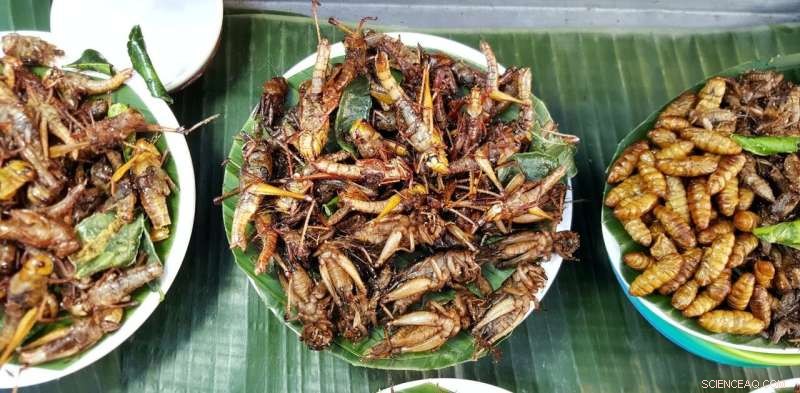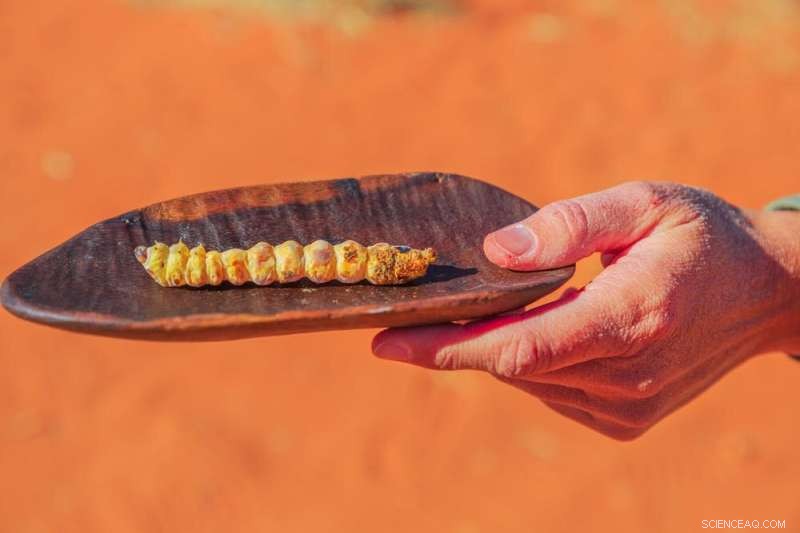
Crédito:Shutterstock
Los insectos son sostenibles, nutritivos y deliciosos. Son consumidos por más de dos mil millones de personas en todo el mundo, principalmente en los trópicos, y han sido un alimento básico en las dietas de los indígenas australianos durante decenas de miles de años.
Sin embargo, comer insectos no es común en Australia. ¿Por qué?
Encuestamos a 601 australianos sobre su experiencia y actitud hacia los insectos comestibles. Nuestros hallazgos ofrecen información sobre qué factores podrían convencer a las personas de agregar insectos comestibles a su dieta.
Es importante destacar que descubrimos que los australianos no se desaniman por el factor "repugnante" de comer insectos, y estarían dispuestos a probarlos como una alternativa proteica si no fuera por la "falta de oportunidades".
De los adultos que encuestamos, el 56,2 % informó que sería "probable" que comiera insectos en el futuro (un resultado mucho más prometedor que el de una encuesta reciente de la Unión Europea), y esta cifra aumentó al 82,2 % entre los que ya habían probado ellos.
Oportunidades perdidas
Aunque los insectos no suelen aparecer en los menús australianos, hay 60 especies de insectos que se han registrado como una fuente de alimento tradicional para los indígenas australianos, incluidos los gusanos witjuti, las polillas bogong y las hormigas melíferas.
Los antiguos romanos y griegos también comían insectos. Se cree que los países occidentalizados pueden haber perdido el gusto por los insectos comestibles durante el cambio del estilo de vida de cazadores-recolectores a la agricultura y la urbanización.
Los insectos pasaron de cumplir el papel de alimento básico a ser plagas que destruyen los cultivos, y esto puede haber provocado un cambio en nuestra actitud hacia comerlos.
La investigación realizada con australianos mayores ha revelado una tendencia a ver la práctica como repugnante e incompatible con sus creencias personales, lo que genera preocupación de que los insectos comestibles puedan ser reacios a volver a ser una alternativa proteica normalizada y viable.

La larva witjuti comestible es la larva de la gran polilla de la madera cósida (Endoxyla leucomochla), originaria de Australia. Crédito:Shutterstock
Resulta que la mayoría de la gente no es tan aprensiva
But our research (mainly with participants aged 25 to 44 years) shows Aussies have begun to adopt a more positive outlook towards insect-based foods.
Of those surveyed, 35% had previously tried insects, most commonly crickets and grasshoppers. And people who had already tried them were also more open to eating them again, which suggests a "taste" for bugs can be developed. Of those who hadn't tried insects, only 16% reported "disgust" was holding them back.
This paradigm shift may be linked to people expressing more concern for the environmental cost of their food, and a greater interest in adopting healthy dietary habits.
Participants also reported they would be willing to eat insect-based products if it was easier to find out how such foods are beneficial, both from a nutrition and sustainability standpoint.
They said endorsements from governing bodies, as well as more prominence of edible insects in mainstream media, would boost their interest in eating insects—as well as "try before you buy" promotions.
For those willing to give insects a go, insect-based flours (such as bread and biscuits), chocolate-coated ants and crickets were the top choices. Not all species were received the same way, however, with moths and fly larvae not generating such a buzz.
Still, the shift towards a willingness to try insects is promising for Australia's growing edible insect market.
Embracing future foods
With the global population still growing, we will need alternative sources of protein to sustainably meet future food production requirements.
The demand for protein is on the rise and, according to the UN Food and Agriculture Organisation, will have to increase by 76% by 2050. But production is restricted due to Earth's finite resources.
Edible insects have potential as an important future food, offering a nutritious protein source that's more sustainable to produce—using less land, energy and water.